First Things First
With the Windows 10 Creators Update some genius at Microsoft thought it would be fun to remove your Control Panel icons. I have seen several articles showing unnecessarily complicated steps to get them back. Use this program, edit the registry, etc.
It is very easy to get these icons back:
1 – Open File Explorer
2 – Click the View tab
3 – Click Options > Change folder and search options
4 – Scroll down and select Show all folders (click Apply)
5 – Control Panel now appears in the left window of File Explorer.
6 – To create shortcut click and hold on the Control Panel icon and drag it onto the desktop.
You can keep the shortcut there, move it, rename it, etc.
7 – There is also the standard right-click options.
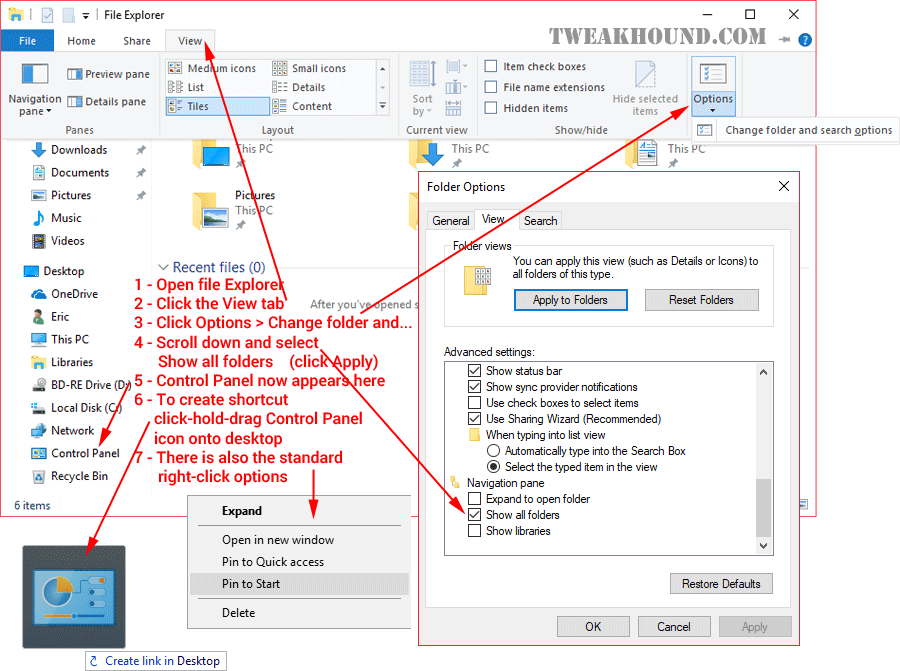
Now, let’s adjust the control Panel view to Large Icons. This will make everything else easier. Right-click on Start > Control Panel Or Press the Windows + R keys > type powercfg.cpl
Choose View by: Large Icons
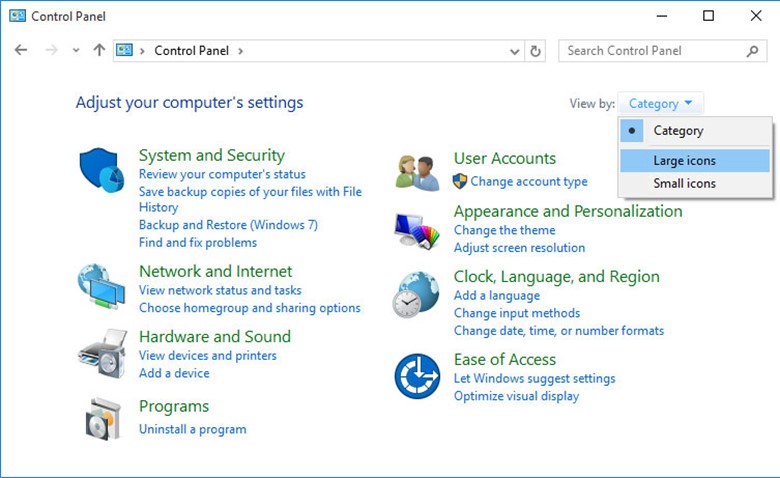
Now isn’t this better?
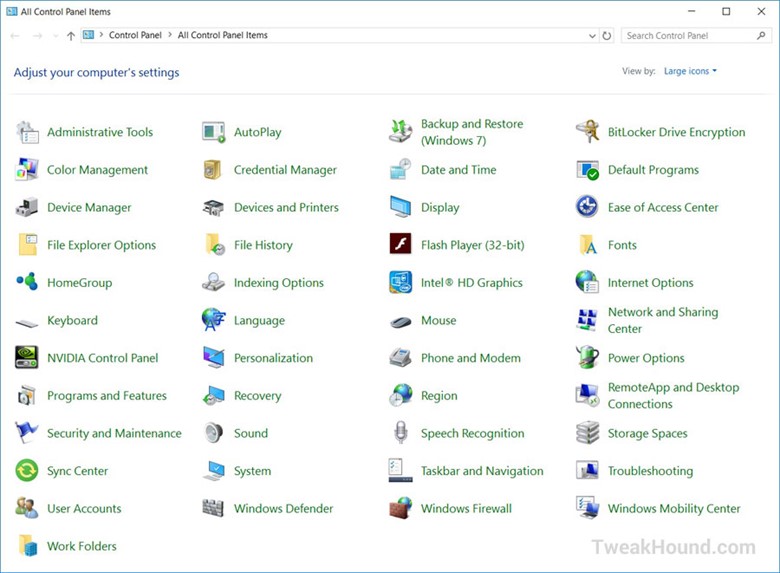
UAC
Not to be rude but I’m tired of the diatribe bandied about on this topic. I’m not going to debate this topic with anyone for any reason. I disable (kinda) it on my computers. See my article Windows 7 UAC – Quick notes on why I disable it for why. I am not recommending to anyone that they disable UAC. The choice is yours as are the consequences. Make an informed decision.
Note – This does NOT “completely” disable UAC. It just eliminates prompts.
See:
User Account Control (Microsoft)
How User Account Control works (Microsoft)
To Disable UAC:
– Type or copy and paste UserAccountControlSettings.exe into the run box or Search charm.
– In the resulting window, move the slider all the way to the bottom.
– Reboot
To Configure UAC:
– Type or copy and paste UserAccountControlSettings.exe into the run box or Search charm.
– In the resulting window, move the slider all the way to the top (see comments above).
– Reboot
Completely Disable UAC
I do not recommend this. I do not do this.
DO NOT DISABLE THIS IF YOU USE MICROSOFT UNIVERSAL APPS
Windows + R keys > gpedit.msc > Computer Configuration > Windows Settings > Security Settings > Local Policies > Security Options > set User Account Control: Run all administrators in Admin Approval Mode to Disabled > Reboot
or via regedit:
[HKEY_LOCAL_MACHINE\SOFTWARE\Microsoft\Windows\CurrentVersion\Policies\System]
“EnableLUA”=dword:00000000
God Mode
While we’re at it, let’s do this oldie but goodie.
A while back a tweak to add a shortcut to all control panel items (actually All Tasks) surfaced. It soon began to spread around the web as God Mode. People who fancy themselves as “Windows Experts” immediately scoffed at this tweak. Although the name given to it was a little silly the tweak is pretty handy and I like it. This gives you a ton of Control Panel and Admin tools in one place. Highly recommended.
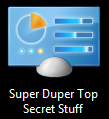
You can make a God Mode shortcut for this by right-clicking on the Desktop, within a partition, or in a folder > choose New > Folder > enter God Mode.{ED7BA470-8E54-465E-825C-99712043E01C} where it says New Folder. You can replace the name God Mode with anything you like. I used Super Duper Top Secret Stuff just to amuse myself. You can also Pin this.
Tips For This Guide
The Windows + Pause|Break keys
The Windows + Pause|Break keys shortcut is one of my favorite shortcuts. This shortcut brings up the System Properties window. From there you can access a number of other tools and settings windows.
Windows + R keys
Throughout this guide I will often say press the Windows + R keys to enter the run box. This is “old school” and it’s just the way I do things. You can accomplish the same thing by typing the command in the Search Box, or a 3rd Party start menu, or the…
Windows + S keys
Pressing the Windows + S keys brings up the search box. Handy if you remove the search box from the taskbar as I do.
The Search Box
While there is a definite speed advantage to the Windows + R keys in many ways it is a superior way of doing things. It allows you to find apps and settings when you don’t know the command and/or where to find it. Let’s say you want to delete that loser of an Ex’s user account from your computer but you aren’t sure where to go. Just type “user” in the search box and look at those options.
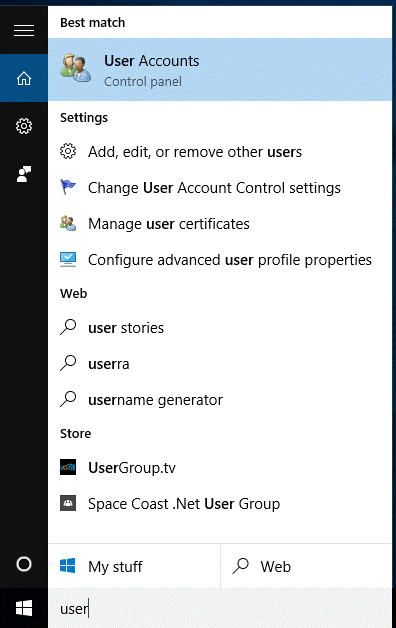

I think Classic Shell is far superior to anything out there and free.
Hi Eric,
Excellent job. I will have to re-read the whole thing again… My favorite is moving all the DOCS, Pix and Misc. to a separate drive. In this way, I can do more frequent OS backups that will not fill the backup drive too fast.
Issues on my end:
1. When I try to change Geolocation Service to AUTOMATIC, I get “the system cannot find the file specified”. Any suggestions?
2. On your tweaks p. 13, you have more options. On Shutdown settings, I only have SLEEP and LOCK. You additionally have: Turn on fast startup and Hibernate. Are you running Win 10 Enterprise?
Suggestion: It would be great to compile everything into a PDF file that can serve as desktop reference.
Geolocation: https://technet.microsoft.com/en-us/windows/dn764773.aspx?f=255&MSPPError=-2147217396
Shutdown settings may vary depending on setup.
PDF: https://www.tweakhound.com/buy-tweaking-windows-10/
This is funny and just for a point of reference I have worked in IT primarily in Computer and Network installation, support, maintenance for 21 years now and have read Eric’s guides since Windows XP as it is one of the easiest ways to get great info on the manipulation of Operating systems and he is about as complete as it gets.
Anyway the way I organize my files is on seperate hard drives internally and with USB media containers most often now (I have 2 64 Gb’s I use and on 256 GB one as well given to me by Corsair. My computer is set up with 3 hard drives (which I would like to grow to 5 with two or 7 in raid sets in 0,1 and 10 (0,1 being options with 5 and 10 being with 7). The first of course is the OS drive otherwise generally known as C:\ and the other two are P:\ programs, and M:\Media which I organize relatively often and I have backups and everything of course external from the OS drive which is also a Corsair Pro SSD and the things on it are often used, and active programs such as Office etcetera but not generally big saves (I like to keep SSD’s relatively light in volume)!
Two things…
1) Excellent job Eric! One thing I miss is the Logoff, Shutdown, and Restart tiles to which I pin to my taskbar…But hey that’s just me..
2) Might as well make it a sixer…LOL
Excellent work! This really takes all the “mystery” out of running and securing this OS…at least for me. A quick “typo” to correct. On page 3, when copying the GOD MODE title, the space between the period after the word MODE, and the first parentheses has to be removed for it to work.
Thank you again for all your hard work!
Fixed. Thanks!
Defragment and optimize your drives bug
There is a bug in Win 10, V 1511 build 10586.17 setting for “defragment and optimize your drives”. If I turn my HDD defrag schedule to ON, my SSD gets switched on too. If I turn OFF SSD defrag, HDD defrag is also turned off. I have defrag for all drives turned off turned OFF and will do it manually.
I have 8Gs of RAM on a 32bit Windows with SSD on a laptop and it boots twice as fast (average 30 sec.) as Windows 10 32 or 64bit (1 min. +) – and Windows 32 bit can only use 4Gs of RAM max.!
Same programs and all drivers all up to date on both so go figure!
https://msdn.microsoft.com/en-us/library/windows/desktop/aa366778%28v=vs.85%29.aspx